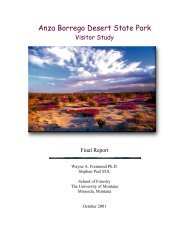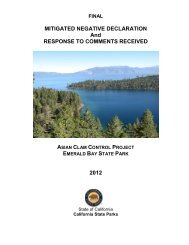Draft EIS/EIR for the San Luis Reservoir SRA Resource ...
Draft EIS/EIR for the San Luis Reservoir SRA Resource ...
Draft EIS/EIR for the San Luis Reservoir SRA Resource ...
Create successful ePaper yourself
Turn your PDF publications into a flip-book with our unique Google optimized e-Paper software.
4. Plan Overview<br />
Ra<strong>the</strong>r, <strong>the</strong> Plan Area, when viewed with o<strong>the</strong>r lakes and reservoirs in <strong>the</strong> vicinity,<br />
can provide an opportunity <strong>for</strong> unique management actions.<br />
Note that <strong>the</strong> designation of allowable uses in different management zones of <strong>the</strong><br />
Plan Area does not require that <strong>the</strong> allowable uses be implemented. In particular,<br />
<strong>the</strong> management zones only indicate what lands are suitable <strong>for</strong> different<br />
recreation activities; it does not require <strong>the</strong> activities to be implemented,<br />
facilitated, or encouraged.<br />
Map 8 illustrates <strong>the</strong> existing Plan Area management zones. The proposed zones<br />
<strong>for</strong> <strong>the</strong> Plan Area are divided into water- and land-based facilities and uses as<br />
follows:<br />
Water-Based Management Zones<br />
• Suburban (S)<br />
• Rural Developed (RD)<br />
• Rural Natural (RN)<br />
Land-Based Management Zones<br />
• Administration and Operations (AO)<br />
• Frontcountry (FC)<br />
• Backcountry (BC)<br />
This Plan uses <strong>the</strong> Water Recreation Opportunity Spectrum (WROS) management<br />
tool (Aukerman et al. 2003) to identify water-based management zones. The<br />
WROS provides detailed guidance <strong>for</strong> <strong>the</strong> management of lakes, reservoirs,<br />
wetlands, estuaries, bays, rivers, tidal basins, coastal zone areas, and o<strong>the</strong>r water<br />
and land-related areas. The primary purpose of <strong>the</strong> WROS is to help recreation<br />
and resource professionals make better decisions about <strong>the</strong> recreation use and<br />
management of lakes, reservoirs, and o<strong>the</strong>r water bodies. The WROS is a tool to<br />
inventory, plan, and manage water recreation resources. In addition, <strong>the</strong> WROS<br />
can accommodate changes in public recreation demand and values, best available<br />
science, social and economic values and circumstances, and professional<br />
experience and knowledge gained from applying this system over time.<br />
The WROS is based on <strong>the</strong> concept that <strong>the</strong>re is diversity among recreationists,<br />
water resource settings, and <strong>the</strong> agencies that manage <strong>the</strong>se resources. Each<br />
specific water resource has a niche and contributes to a larger system of diverse<br />
recreation opportunities. The overarching goal of WROS is to provide planners<br />
and managers with a framework and procedure <strong>for</strong> making better decisions <strong>for</strong><br />
conserving a spectrum of high-quality and diverse water recreation opportunities<br />
(Aukerman and Haas 2002).<br />
WROS represents a spectrum of six types of water recreation opportunities:<br />
4-28 <strong>San</strong> <strong>Luis</strong> <strong>Reservoir</strong> <strong>SRA</strong><br />
<strong>Draft</strong> RMP/GP and <strong>Draft</strong> <strong>EIS</strong>/<strong>EIR</strong>
















